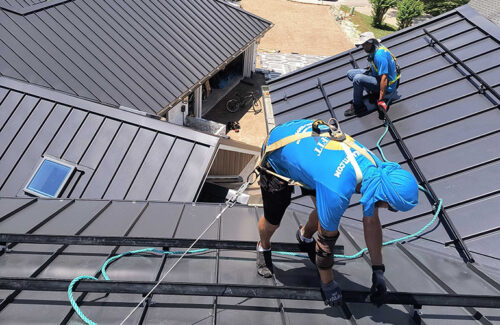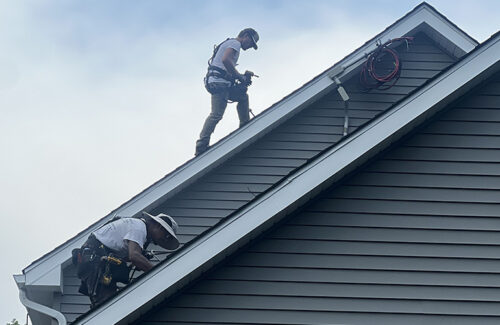The U.S. solar industry has experienced unprecedented growth with tax credits spurring new PV deployment. The Inflation Reduction Act (IRA) extended historic incentives that have energized the market on and off for 20 years and introduced bonus credits to further boost savings on solar PV.

Credit: Solar-Fit
For many, these tax credits widened the door for entry to owning a solar project. Then, the Trump Administration devised and signed into law the One Big Beautiful Bill Act (HR1), which has axed virtually all solar incentives championed by the IRA. The smallest segment of the market will be the first without them.
Per HR1, the residential investment tax credit (25D) will expire at the end of 2025. Both residential solar and standalone storage projects must be installed by December 31, 2025, to receive the 30% tax credit. However, third party-owned residential PV projects — with leases or power purchase agreements — have a longer runway into 2026.
Third-party ownership isn’t the standard for residential solar, and some states don’t even have policies enabling these PPAs. Many residential installers are independent, regional companies building solar projects to be owned by homeowners.
These credits sunsetting at year’s end threaten the extra momentum residential solar has enjoyed since late 2022 when the IRA was passed. Despite that, contractors in the game long enough know that this isn’t the first time solar subsidies have disappeared.
“There’s going to be solar out there without the tax credit. There was solar being installed before the tax credit,” said Aron Cromwell, CEO of Cromwell Solar, a Kansas-based contractor in business since 1982.
How installers adapt to these market shifts will ultimately determine who remains in business post-IRA.
Market realities
Cromwell Solar originally offered indoor environmental remediation services like asbestos removal and eventually got into solar installation. The company has installed solar in Kansas (which is 50th in the nation for total installed solar capacity, according to Solar Energy Industries Association rankings) since the technology cost $12/W. Cromwell Solar was able to boost installation from utility rebates in neighboring states.
One of those was the Missouri Clean Energy Act, which was introduced by a former Cromwell Solar employee and passed into law in 2008. It enacted a renewable energy standard in the state requiring utilities to source 15% of their electricity supply from renewables. Solar projects below 25 kW could receive a rebate of up to $2/W.
Then one day in 2013, it was gone.
“It was an absolute bloodbath in the industry. There was no warning. There was no off-ramp,” Cromwell said. “It was overnight, and it was actually because the utility calculated their cap wrong and they had to undo it.”
While the ITC is making an abrupt exit in the residential solar market come 2026, customers are clamoring to take advantage of the federal tax credit while it’s still active. This demand, while likely temporary, is still new business in the short-term.
“At first, I was scratching my head like, ‘Why? Why is this happening?’ But now, as I rethink it, it really, on the residential side, was a huge jumpstart to sales,” said Melissa Sims, managing member with Ecological Systems, a New Jersey solar contractor founded in 1985. “We don’t have a lot of time but … since the Fourth of July, our requests have come in probably three- to four-times what is the normal volume.”
Electricity prices are increasing from inflation, upgrading outdated grid infrastructure, the addition of new data centers and the country’s reprioritization of fossil fuel energy sources in HR1.
“I’ve been praying for the day that the cost of electricity is high enough and the cost of our materials, our installations, are low enough that we don’t need any incentives,” Cromwell said. “Because I’ve watched over and over the number of solar companies that just balloon and then pop. Then it happens all over again on a cycle. I want all the incentives that we can get for the industry. It’s good for us. But I, at the same time, just wish we could live without them.”
Adjacent services
Once the dust has settled and the subsidies have ended, the demand for new solar installations may not be as high, but demand for maintenance on existing installs will continue to grow.
The effects of HR1 were felt before it even passed, with manufacturers and high-profile solar installation companies like Sunnova filing for bankruptcy. Before then, there was a wave of closures and slowdown in private solar financing from rising interest rates. Even prior to President Donald Trump’s second term, the residential market was left with many abandoned solar projects.

Credit: Ecological Systems
If companies cannot survive without these subsidies, more home arrays will likely be left without their original installers. Customers will need someone to maintain these systems and reliable solar contractors have the chance to assist.
“There’s a heck of a lot of solar panels out there,” Cromwell said. “Maintenance is a whole different sort of market, different sort of business, but it’s related, and a lot of folks [in solar] have those skills.”
The work isn’t stagnant, either. When maintaining or reinstalling systems, there’s an opportunity to update them with new PV modules or energy storage.
While they won’t be as affordable without the subsidies, solar and energy storage technologies reportedly cost their lowest in 2024. Energy storage adoption has increased alongside solar through these waning subsidies, and it makes sense in states like California that have altered net-metering compensation based on time-of-use rates. Energy storage has been especially valuable in regions of the country that have been hit the hardest by increasingly extreme weather.
“It’s really become the Holy Grail of solar,” said Bill Gallagher, president of Solar-Fit, a solar contractor working in Florida since 1975. “Most of the systems we’re putting in now have batteries for a variety of reasons, and it’s another wonderful thing to see here.”
Residential solar occupies a cross-section of many different trades. There are complementary technologies that contractors can naturally add to their services, like electric vehicle chargers. With the right experience, it’s possible to offer general electrician services in addition to PV. Roofs often need replaced or repaired when commissioning solar too.
“We have no control over the political arena,” Gallagher said. “We either adjust, or we vanish.”
Additional resources and operational strategies
Residential solar installers have a chance to assess their businesses before an inevitable market shift in 2026. Focusing on aspects of operations like company overhead, relationships with vendors, related trades and customers and expansion opportunities can mean the difference between shuttering and staying on the roof.
“Because we’ve been in a marginal solar market for so long, we’ve had to be very nimble,” Cromwell said. “We have a large geographical reach. We do commercial, we do residential, we do institutional. We’ll do batteries, generators … It is important.”
To stay informed on the latest federal and regional solar policy shifts, contractors should stay in touch with national, state and local industry groups. These groups help to shape policy that bolsters the market and petition against proposals that threaten it. Sims with Ecological Systems serves as an at-large board director for the Mid-Atlantic Solar & Storage Industries Association.
“You don’t have to be on the board to do that. Anybody can do that,” she said. “Having that support from other companies, having lobbyists, having people reading the legislation who are understanding it, because that’s another tricky part — when you have to read these 1,000-page documents, and they don’t read that easy. They’re written by lawyers, written by scholars, not written by a layperson.”
Just because federal solar subsidies are waning, doesn’t mean regional state and utility credits are off the table. By focusing on regional solar policy efforts, considering expanded service offerings and assessing business operations, contractors can persevere through this challenging time.
“I’ve always said that when you tighten your belt, it makes your shoulders look bigger,” Gallagher said. “Stay lean, stay energized. Have a positive attitude. Just figure out a way to pivot — to turn that lemon into lemonade.”


















